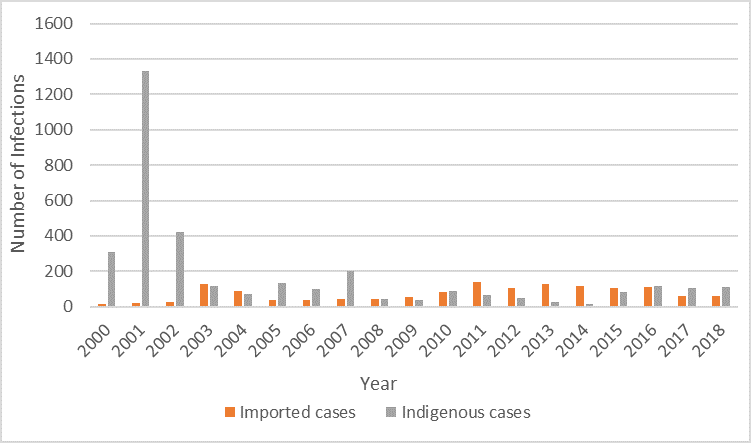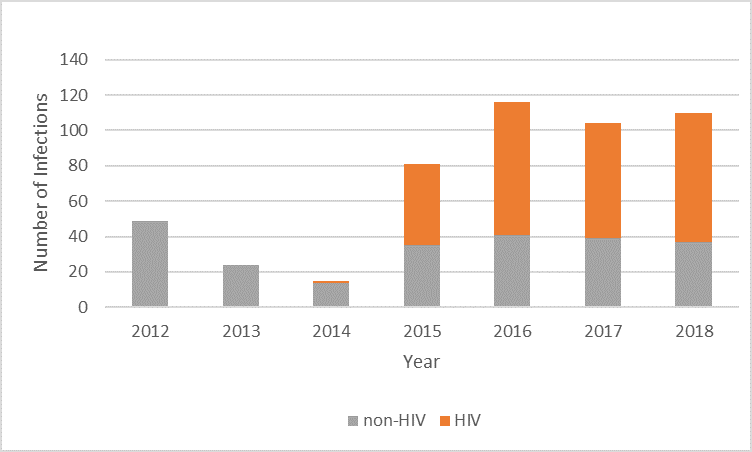Shigellosis
Background
Shigellosis is a diarrheal disease caused by Shigella species. Shigella strains are Gram-negative, facultatively anaerobic, nonmotile rods classified in the family Enterobacteriaceae. There are four different species of Shigella: S. dysenteriae (Group A), S. flexneri (Group B), S. boydii (Group C), and S. sonnei (Group D). Group A, B, and C are further divided into 15, 8, and 19 species. The only significant reservoir is humans. Shigella organisms can survive transit through the stomach since they are less susceptible to acid than other bacteria; the infective doses can be as low as 10-100 organisms.
It mainly by direct or indirect fecal-oral transmission from a symptomatic patient or asymptomatic carrier. Transmission occurs when people put something in their mouths or swallow something that has come into contact with stool of a person infected with Shigella. The incubation period is usually 1-3 days, but may ranges from 12-96 hours and up to 1 week for S. dysenteriae type 1.
Shigellosis is an acute bacterial disease involving the distal small intestine and colon. Symptoms of shigellosis characterized by loose stools accompanied by fever, nausea, and sometimes toxemia, vomiting, abdominal pain, and tenesmus. Stools may contain blood and mucus because of mucosal ulceration. Severity and case-fatality rate vary with the host (age and nutrition state) and serotype. In persons with healthy immune systems, symptoms usually self-limited, lasting on about 4 to 7 days. Mild and asymptomatic infections occur. Possible complications include post-infection arthritis, blood stream infections, seizures, and hemolytic-uremic syndrome or HUS. Antibiotic treatment can only shorten the duration of illness by about 1-2 days. However, because most individuals will clear the infection spontaneously, antibiotic treatment is not essential unless those who are immunocompromised or who develop severe illness. Although the increasing antimicrobial resistance of Shigella species is a major problem worldwide. Thus, antibiotic susceptibility testing is essential for management of all patients with Shigella infection.
Epidemiology
Shigella species are a common cause of bacterial diarrhea worldwide, especially in developing countries. Bacterial dysentery due to Shigella species is a major cause of morbidity and mortality; 165 million cases occur annually worldwide, with 1 million associated deaths.
Shigellosis is one of the Category 2 communicable diseases in Taiwan, and all cases of shigellosis should be reported to health departments. A decade ago, many outbreaks took place in indigenous areas, especially in the eastern part of Taiwan. After promoting a series of surveillance and management plans, such as providing access to safe drinking water and leading health education programs, the number of indigenous cases decreased significantly. The incidence rate decreased from 2007 through 2014 (domestically acquired shigellosis in Taiwan is 0.31 per 100,000 population in recent 10 years). However Shigellosis outbreaks among HIV infected persons since March, 2015 and resulted in the incidence rate increased. S. sonnei and S. flexneri are the common strains in Taiwan. The increasing of imported cases usually associated with not only traveling to Southeast Asia but also with importing foreign workers from these areas.
Figure 1. Number of Shigella Infections by Year– Taiwan, 2000-2018

Figure 2. Number of Shigella Co-infection with HIV by Year– Taiwan, 2012-2018

Shigellosis Surveillance in Taiwan
- Taiwan National Infectious Disease Statistics System–Shigellosis
- Self–reporting through the toll–free 1922 hotline or the local health bureau.
Prevention and Control
- General measures to improve hygiene are important. Frequent handwashing with soap andwater is important for prevention, particularly after using the restroom and prior to foodpreparation.
- Avoid swallowing water from ponds, lakes, or untreated swimming pools.
- Use barriers during sexual contact, including oral sex and genital contact. Wash hands and genitals with soap before and after sexual contact.
- Avoid sexual activity with those who have diarrhea or who recently recovered from diarrhea.
- Avoid swimming until you have fully recovered from shigellosis.
- During acute illness, use enteric precautions. Terminal cleaning is very important in health care settings.
- People with known shigellosis should not handle food or provide child or patient care until samples are found to be Shigella-free.
- Prophylactic administration of antibiotics is not recommended.
- Certain measures are needed to tackle institutional outbreaks, including separate housing for cases and new admissions, a rigorous program of supervised hand washing, and regular health education for patients and attendants.
- When traveling internationally, follow food and water precautions strictly and wash hands with soap frequently.
FAQs
- What is shigellosis?
Shigellosis is an infectious disease caused by Shigella species. Symptoms of shigellosis typically start 1–2 days after exposure and include diarrhea, fever, abdominal pain and tenesmus. In persons with healthy immune systems, symptoms usually last about 5 to 7 days. Persons with diarrhea usually recover completely, although it may be several months before their bowel habits are entirely normal. - How do people catch Shigella?
Shigella germs are present in the stools of infected persons. Shigella is very contagious; exposure to even a tiny amount of contaminated fecal matter—too small to see– can cause infection. Transmission of Shigella occurs when people put something in their mouths or swallow something that has come into contact with stool of a person infected with Shigella. This happens when basic hygiene and handwashing habits are inadequate and can happen during certain types of sexual activity. Flies can breed in infected feces and then contaminate food. - Who are at risk?
People who are young children, gay, bisexual, and other men who have sex with men (MSM), and travelers to developing countries may be more likely to get shigellosis. The elderly, the debilitated, and the malnourished of all ages and those infected with HIV are particularly susceptible to severe disease and death. Many outbreaks are related to childcare settings and schools, and it commonly spreads from young children to their family members and others in their communities.
More Information
Images


